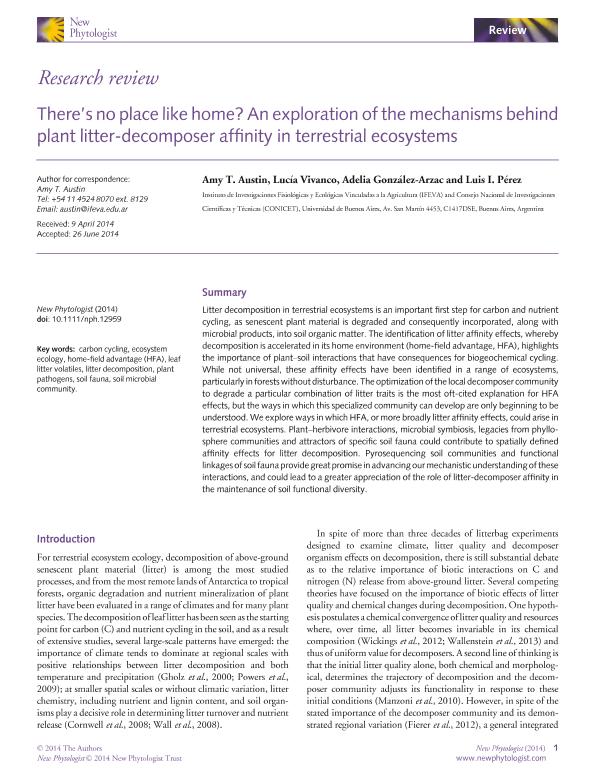Mostrar el registro sencillo del ítem
dc.contributor.author
González Arzac, Adelia

dc.contributor.author
Vivanco, Lucía

dc.contributor.author
Austin, Amy Theresa

dc.contributor.author
Perez, Luis Ignacio

dc.date.available
2016-02-16T19:56:05Z
dc.date.issued
2014-10
dc.identifier.citation
González Arzac, Adelia; Vivanco, Lucía; Austin, Amy Theresa; Perez, Luis Ignacio; There's no place like home? An exploration of the mechanisms behind plant litter-decomposer affinity in terrestrial ecosystems; Wiley; New Phytologist; 204; 2; 10-2014; 307-314
dc.identifier.issn
0028-646X
dc.identifier.uri
http://hdl.handle.net/11336/4213
dc.description.abstract
Litter decomposition in terrestrial ecosystems is an important first step for carbon and nutrient cycling, as senescent plant material is degraded and consequently incorporated, along with microbial products, into soil organic matter. The identification of litter affinity effects, whereby decomposition is accelerated in its home environment (home-field advantage, HFA), highlights the importance of plant-soil interactions that have consequences for biogeochemical cycling. While not universal, these affinity effects have been identified in a range of ecosystems, particularly in forests without disturbance. The optimization of the local decomposer community to degrade a particular combination of litter traits is the most oft-cited explanation for HFA effects, but the ways in which this specialized community can develop are only beginning to be understood. We explore ways in which HFA, or more broadly litter affinity effects, could arise in terrestrial ecosystems. Plant?herbivore interactions, microbial symbiosis, legacies from phyllosphere communities and attractors of specific soil fauna could contribute to spatially defined affinity effects for litter decomposition. Pyrosequencing soil communities and functional linkages of soil fauna provide great promise in advancing our mechanistic understanding of these interactions, and could lead to a greater appreciation of the role of litter-decomposer affinity in the maintenance of soil functional diversity.
dc.format
application/pdf
dc.language.iso
eng
dc.publisher
Wiley

dc.rights
info:eu-repo/semantics/openAccess
dc.rights.uri
https://creativecommons.org/licenses/by-nc-sa/2.5/ar/
dc.subject
Home Field Advantage
dc.subject
Litter Decomposition
dc.subject
Review
dc.subject
Plant-Soil Interactions
dc.subject.classification
Ecología

dc.subject.classification
Ciencias Biológicas

dc.subject.classification
CIENCIAS NATURALES Y EXACTAS

dc.title
There's no place like home? An exploration of the mechanisms behind plant litter-decomposer affinity in terrestrial ecosystems
dc.type
info:eu-repo/semantics/article
dc.type
info:ar-repo/semantics/artículo
dc.type
info:eu-repo/semantics/publishedVersion
dc.date.updated
2016-03-30 10:35:44.97925-03
dc.journal.volume
204
dc.journal.number
2
dc.journal.pagination
307-314
dc.journal.pais
Estados Unidos

dc.journal.ciudad
Hoboken
dc.description.fil
Fil: González Arzac, Adelia. Consejo Nacional de Investigaciones Científicas y Técnicas. Oficina de Coordinación Administrativa Parque Centenario. Instituto de Investigaciones Fisiológicas y Ecológicas Vinculadas a la Agricultura; Argentina
dc.description.fil
Fil: Vivanco, Lucía. Consejo Nacional de Investigaciones Científicas y Técnicas. Oficina de Coordinación Administrativa Parque Centenario. Instituto de Investigaciones Fisiológicas y Ecológicas Vinculadas a la Agricultura; Argentina
dc.description.fil
Fil: Austin, Amy Theresa. Consejo Nacional de Investigaciones Científicas y Técnicas. Oficina de Coordinación Administrativa Parque Centenario. Instituto de Investigaciones Fisiológicas y Ecológicas Vinculadas a la Agricultura; Argentina
dc.description.fil
Fil: Perez, Luis Ignacio. Consejo Nacional de Investigaciones Científicas y Técnicas. Oficina de Coordinación Administrativa Parque Centenario. Instituto de Investigaciones Fisiológicas y Ecológicas Vinculadas a la Agricultura; Argentina
dc.journal.title
New Phytologist

dc.relation.alternativeid
info:eu-repo/semantics/altIdentifier/url/http://onlinelibrary.wiley.com/doi/10.1111/nph.12959/abstract
dc.relation.alternativeid
info:eu-repo/semantics/altIdentifier/doi/http://dx.doi.org/10.1111/nph.12959
dc.relation.alternativeid
info:eu-repo/semantics/altIdentifier/issn/0028-646X
Archivos asociados
